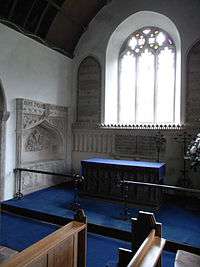Holcombe Burnell
Holcombe Burnell is a civil parish in Devon, England, the church of which is about 4 miles west of Exeter City centre. There is no village clustered around the church, rather the nearest village within the parish is Longdown. Only the manor house and two cottages are situated next to the church. The former manor house next to the church is today known as Holcombe Burnell Barton having subsequently been used as a farmhouse. The manor was in the historical Hundred of Wonford.
Church of St John the Baptist

The church was dedicated originally to St Nicholas, mentioned in a charter dated 1150.[1] In the 15th century the manor was acquired by a member of the Denys family of Orleigh in Devon, and the church was then substantially reconstructed. The church was restored in the Victorian era in 1843-4, to the plans of the Exeter architect John Hayward with Henry Lloyd of Bristol. The north aisle was added at that time. The church contains a rare Easter Sepulchre, situated on the north side of the chancel. The advowson of the church was acquired by the Bishop of Wells, which made it into a prebendary for one of its canons. The advowson was acquired by the Bishop of Exeter in about 1850.
The altar is an ancient Spanish chest in carved oak from Culver House, one of the principal residences in the parish. The font is 15th century. There existed formerly next to the manor house a private chapel, demolished in the 18th century, the only remains of which are some stone blocks made into a mounting block by the church gate.
Descent of the manor
The Domesday Book of 1086 records the manor as held by Queen Matilda. Before the Norman Conquest it had been a possession of Brictric, the powerful thane and possible lord of Bristol based in Gloucestershire. After the death of Queen Matilda the manor was granted by the king to Tetbald FitzBerner, one of King William's knights. The manor derives its appellation "Burnell" from a corruption which has developed over the centuries of the name "Berner".
Denys
The manor was held from the 15th century by a branch of the Denys family originally established in Devon in the 12th century at Orleigh in the parish of Buckland Brewer near Bideford. A cadet branch of Dennis of Orleigh settled at Holcombe Burnell and bore the arms of Orleigh differenced: Ermine, three Danish battle axes gules (three red battle-axes on a white background with black ermine spots).
Thomas Denys (d. 1498) of Holcombe Burnell married Janera Loveday, daughter of Philip Loveday of Sneston in Suffolk, and their son was Sir Thomas Denys (c. 1477–1561), a prominent lawyer who served as Sheriff of Devon nine times between 1507/8 to 1553/4 and as MP for Devon. He married twice, firstly to Anne, widow of Thomas Warley a Treasury official and secondly to Elizabeth Donne, widow of Sir Thomas Murfyn, Lord Mayor of London.
Sir Thomas is notorious as having supervised the burning at the stake of the Protestant martyr Thomas Benet in Exeter in January 1531/2. His eldest son was Sir Robert Denys (d. 1592), MP for Devon in 1555 and Sheriff of Devon, who acquired Bicton House. It is likely that the Easter Sepulchre in the church is his tomb and monument.[2] Sir Robert Denys married firstly Mary Blount (a first cousin of Lady Jane Grey (1536/7-1554) Queen of Nine Days), one of the two daughters and co-heiresses of William Blount, 4th Baron Mountjoy (c.1478–1534), KG,[3] and his wife Dorothy Grey, daughter of Thomas Grey, 7th Baron Ferrers of Groby, 1st Earl of Huntingdon, 1st Marquess of Dorset (1455–1501), KG, father of Henry Grey, 1st Duke of Suffolk, 3rd Marquess of Dorset (1517–1554), KG, and grandfather of Lady Jane Grey.[4][5] In March 1591 he founded the Livery Dole Almshouses in Heavitree Road, Exeter, the building of which he requested in his will should be completed by his son Sir Thomas Denys (1559–1613) (erroneously stated on a stone tablet above the entrance gate to have been his brother). The buildings were completed in 1594.[6]
Sir Thomas Denys married Anne Paulet, daughter of William Paulet, 3rd Marquess of Winchester, and left two co-heiresses:
- Anne Denys, who married Sir Henry Rolle (d. 1616) of Stevenstone in Devon, an ancestor of Baron Rolle (d. 1842) and Barons Clinton, the latter of whom restored Livery Dole after the World War II bomb damage. The manor of Bicton passed thereupon to the Rolle family, with whose descendants it remained until the 20th century.
- Margaret Denys (d. 1649), married in 1623 Sir Arthur Mainwaring of Ightfield, Shropshire, carver to Prince Henry, eldest son of King James I.
Principal houses
The principal historic houses in the parish are as follows:

Culver House
An early example of a neo-Tudor house, the original house was built in the mid 18th century by Richard Stephens, JP and partly rebuilt in 1835 by his son Rev. Richard Stephens to the design of the architect George H. Smith; altered by Edward Byrom in 1872-5 to the plans of Alfred Waterhouse.
Holcombe Burnell Barton
The former manor house, built by Sir Thomas Denys (d. 1561), largely re-built in the early 17th century.
Perridge House
A stucco Regency house built by Josiah White to the plans of the architect George Byfield, in 1813, as the dated hopper-heads to the guttering record.
See also
Sources
- Chalk, Peter J., A Brief History of the Church of Saint John the Baptist Holcombe Burnell, 2006 (Church leaflet)
- Cherry, Bridget & Pevsner, Nikolaus, The Buildings of England: Devon, London, 1991, pp. 485–6, Holcombe Burnell
- Lysons, Samuel, Magna Britannia
References
- ↑ Chalk
- ↑ Hoskins, W.G., "Devon", 1954
- ↑ Vivian, 1895, p.280, pedigree of Denys
- ↑ Vivian, 1895, p.102, pedigree of Bonville
- ↑ Oxford Dictionary of National Biography, article by Cooper, J.P.D.
- ↑ Worthy, Charles. History of the Suburbs of Exeter, 1892
Coordinates: 50°43′N 3°38′W / 50.717°N 3.633°W